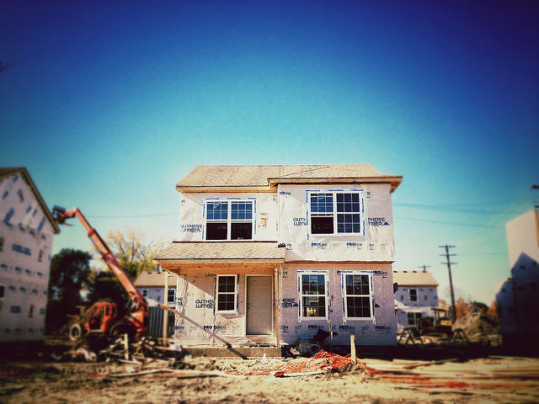More than any other age group, Americans between the ages of 18 and 34 feel homeownership is an important part of achieving the American Dream, according to the results of a recently conducted survey. The survey found overall confidence in the housing market is down slightly from last year but aspirations for homeownership are at their highest level in two years. That is largely driven by young Americans who, in addition to expressing a desire to become homeowners, were also more optimistic about home price growth and, among current renters, whether or not they’d someday be able to afford their own home. Millennials are often portrayed as having less interest in homeownership than their parents or grandparents mostly because they’ve been slower than previous generations to enter the housing market. The survey results are encouraging because they show the reverse to be true. It is also good news for the overall housing market, as the number of first-time buyers has lagged behind historical norms over the past few years. More millennial home buyers would boost growth and provide further stability for the housing market. Conducted by Pulsenomics, the survey adds to growing evidence that residential real estate continues to be resilient despite recent economic uncertainty and volatility in the financial markets. More here.
Archive for March 2016
Mortgage Rates Move Up, So Does Buyer Demand
According to the Mortgage Bankers Association’s Weekly Applications Survey, average mortgage rates moved up across all loan categories last week. Increases were seen on 30-year fixed-rate loans with both conforming and jumbo balances, as well as loans backed by the Federal Housing Administration and 15-year fixed-rate mortgages. Though rates remain low by historical standards, last week’s increase slowed refinance demand – which dropped 2 percent from the previous week. Lynn Fisher, MBA’s vice president of research and economics, told CNBC that falling refinance activity has affected average loan size due to the fact that even minor interest rate fluctuations can have a significant effect on larger loans. “Mortgage markets continued to retrench last week,” Fisher said. “Declining refinance activity was accompanied by falling average loan sizes for refinance applications, which have decreased for the third consecutive week after reaching their survey peak.” Purchase demand, on the other hand, was up from the week before. The 4 percent jump in prospective buyers requesting loan applications pushed purchase activity 30 percent above where it was at the same time last year. The MBA’s weekly survey has been conducted since 1990 and covers 75 percent of all retail residential mortgage applications. More here.
More Americans Say Now’s The Time To Buy
A rising number of Americans say now is a good time to buy a house, according to the results of Fannie Mae’s most recent Home Purchase Sentiment Index. The Index – which measures Americans’ perception of the economy and housing market, as well as their personal financial situation – found a 4 percent improvement in the number of respondents who felt it was the right time to buy. That gain could be due to the fact that Americans increasingly feel confident that they aren’t in danger of losing their jobs. It could also be attributed to a feeling that home price increases are beginning to slow. Doug Duncan, Fannie Mae’s senior vice president and chief economist, says slower price appreciation could bring some relief to buyers. “Our February results show the most modest consumer home price expectations since late 2012,” Duncan said. “For consumers who think it’s a bad time to buy a home, whose share has trended up from its recent low last November, high home prices have been an increasingly contributing factor. A slower pace of home price appreciation may provide some relief for potential homebuyers, especially first-time buyers who couldn’t reap the benefits of selling a home at high prices to buy another one.” This combination of increasing financial security and a positive perception of market conditions could help motivate more Americans to think about buying a house this year. More here.
Credit Availability Unchanged In February
Each month, the Mortgage Bankers Association releases a measure of mortgage credit availability in an effort to track whether lending standards are easing or tightening. The index looks at credit score, loan type, and loan-to-value ratio, as well as other factors that determine whether or not a borrower will be eligible for a loan. According to the most recent release, mortgage credit availability was unchanged in February, though the components gauging conforming and government loans both eased from the month before. Lynn Fisher, MBA’s vice president of research and economics, said the results were a mixed bag. “Credit availability was flat over the month. Slight declines in conventional programs aimed at low-to-moderate income borrowers were offset by increasing availability of government-backed programs,” Fisher said. “More than half of the investors in our credit availability data set are now offering some form of a conventional low down payment loan program which is targeted at lower income borrowers and first time home buyers and generally allows a down payment as low as 3 percent.” More here.
Majority Of Boomers Want House In Suburbs
The vast majority of baby boomer home buyers say they’d prefer a house in the suburbs, according to a recent study conducted by the National Association of Home Builders. The survey of recent and prospective home buyers – titled Housing Preferences of the Boomer Generation: How They Compare To Other Home Buyers – asked participants how location, design, size, and individual home features might influence their decision to buy a house. The results found two-thirds of respondents prefer a home in the suburbs, while just over a quarter said they’d like to move to a rural area. Among baby boomers, just seven percent said they’d like to live in a central city location. Also among the survey’s highlights, a large majority of buyers said they’d prefer a single-family detached home. Fewer buyers said they’d be willing to pay more for a house out of concern for the environment. In fact, just 14 percent of respondents agreed. With regard to home design, 37 percent of baby boomers said they’d be willing to buy a house that didn’t have a living room and 50 percent said they’d prefer a home with a full or partial basement. More here.
Why Buyers Need To Watch The New Home Market
Last year, home sales were stronger than they’ve been in a long time. After years of volatility and gradual gains, the buyer boom was a welcome relief. However, the return of buyer demand created a new concern for housing. As more prospective buyers entered the market, there were fewer homes available for them to choose from. This caused home prices to rise. Now – though the housing market remains strong at a time when global economic uncertainty has slowed the U.S. economy – analysts and industry experts are keeping an eye on housing affordability and what affect it may have on sales in 2016. Sean Becketti, Freddie Mac’s chief economist, says the issue isn’t going to be resolved quickly. “Housing was one of the few bright spots in the economy last year, and we expect continued improvement in 2016,” Becketti says. “The imbalance between demand for housing and the supply of both houses and apartments has supported rapid growth in both house prices and rents. The gap between demand and supply will not be closed any time soon, thus we project continued house price appreciation in 2016.” In short, how quickly that gap is closed will be determined by how quickly new homes are being built and put up for sale in any particular area. Though rising equity will lead to more homeowners putting their homes up for sale, new home construction is the real key to balancing the market and stopping affordability from becoming a bigger issue – which is why home buyers would be wise to keep an eye on the new home market. More here.
Home Loan Demand Suggests Strong Spring
According to the Mortgage Bankers Association’s Weekly Applications Survey, demand for loans to buy homes is 27 percent higher than it was at the same time last year. This indicates that this spring’s selling season could be even stronger than last year’s. That is encouraging news, especially since recent economic data has suggested activity is slowing. But despite the annual gain, demand for mortgage applications was down 4.8 percent from the week before. The decline was mostly due to a 7 percent drop in the number of borrowers looking to refinance. Refinance activity is usually more volatile than purchase demand – and more sensitive to rate fluctuations. Last week’s dip happened, however, during a week when mortgage rates were down. In fact, the average contract interest rate for 30-year fixed-rate mortgages with both conforming and jumbo balances fell from the week before. So did average rates on loans backed by the Federal Housing Administration. Joel Kan, MBA’s associate vice president for forecasting and industry surveys, says many years of lower-than-normal mortgage rates has reduced the number of homeowners that can benefit from refinancing. “Applications for both conventional and government refinance loans decreased, as the supply of borrowers who could benefit from rates at this level begins to diminish,” Kan told CNBC. The MBA’s weekly survey has been conducted since 1990 and covers 75 percent of all retail residential mortgage applications. More here.







